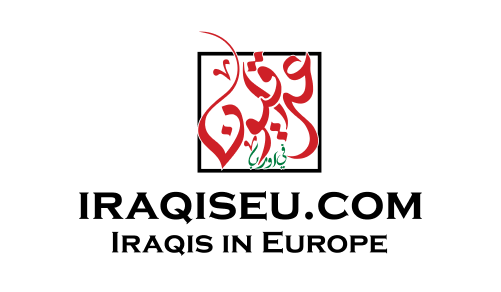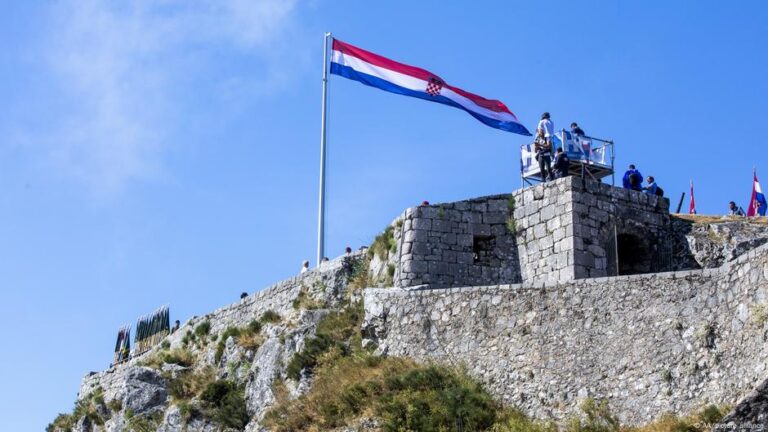Once a year, on August 5, the small sleepy town of Knin in Northern Dalmatia becomes the heart of Croatia’spolitical life. The country’s political and military elite gather under the flag on the castle ruins above the town, and there are patriotic speeches with pathos galore.
It’s the “Day of Victory and Homeland Thanksgiving” and the “Day of Croatian Defenders,” commemorating the military operation “Oluja” (Storm) carried out from August 4 to 7, 1995.
The raising of the oversized flag above Knin Fortress remains to this day a symbol of Croatian troops victory over Serbia during the Yugoslav wars of the 1990s. At that time, the Croatian army and police units recaptured the entire Krajina region on the border with Bosnia in a large-scale offensive within 85 hours — thus capturing the largest part of the third of Croatia’s territory that had been occupied by Serbs since 1991.
Operation Storm also brought about a military turning point in the neighboring war in Bosnia and Herzegovina: In a coordinated action by Croatian and Bosnian-Herzegovinian armies — with limited NATO air support — the long-standing Serbian siege of the western Bosnian city of Bihac was broken and all of Western Bosnia was recaptured. Shortly afterwards, Croatian-Bosnian forces also brought other parts of Bosnia under their control. Serbian-controlled territory shrank from 70% to 49% of the country, ultimately leading to the US-brokered Dayton Peace Agreement.
Victims on both sides
The wars in former Yugoslavia, which began in 1991 with Slovenia and Croatia’s declarations of independence from Yugoslavia and the subsequent Ten-Day War in Slovenia, were provisionally ended. They didn’t officially end until four years later, when NATO fought against Serbia in the Kosovo War, which eventually led to the establishment of an independent state of Kosovo.
Operation Storm brought about a profound and lasting change for the country: during these 85 hours and immediately afterward, approximately 200,000 Serbs left the Krajina area heading towards Serbia. Many were forcibly expelled, but most fled in fear of revenge from advancing Croatian troops. In the preceding years, more than 170,000 Croats had been displaced from Serbian-dominated areas of Croatia, mainly at the beginning of the war. And hundreds of crimes were committed by Serbian troops against Croatian civilians.
As it turned out, this fear was justified: According to the Croatian human rights NGO documenta.hr, there was a lot of looting during Operation Storm. Many Serbian houses and even entire villages were destroyed and set on fire. More than 1,000 Serbian civilians who stayed behind were murdered.
War Crimes Tribunal in The Hague
Even though most of these crimes are well-documented, hardly anyone was prosecuted or convicted for them. Post-war Croatian judicial authorities showed little interest in investigating crimes committed by Croatian soldiers.
And neither did the International Criminal Tribunal for the former Yugoslavia (ICTY) in The Hague find those responsible. While Ante Gotovina, one of the Croatian commanders, and another Croatian army general were sentenced to long prison terms in 2011 over war crimes, both were acquitted in the second instance and released from custody.
Even though many refugees have returned to Croatia since the war, Serbs now have only marginal significance in Croatian society.
Croatia: A heroic victory
Although three decades have passed since Oluja, the assessments of the Serbian and Croatian sides differ significantly. In Croatia, it is clearly viewed positively, seen as a legitimate, justified, and heroic military operation within the framework of a defensive war.
For the 30th anniversary, a large military parade was held in the capital Zagreb on July 31, 2025. A long column displayed all the military equipment available to the Croatian army today. Many soldiers participated, and much technology was shown, with newly acquired French Rafale fighter jets flying over spectators. For the first time, soldiers from other NATO countries participated in such a display, as Croatia has been a member of the alliance since 2009. Two Leopard tanks were borrowed from Germany for the parade: while the Croatian army doesn’t have them yet, they have been ordered.
Croatian President Zoran Milanovic wrote on Facebook about the parade, “We celebrate our victories; we hate nobody. We are completely aware — and I want those who come after us to be aware too — that it was a victory of Croatian soldiers, the Croatian people, and Croatia’s leadership at the time.”
Serbia: A pogrom
On the Serbian side, Operation Storm is considered not only the most significant military defeat in the Yugoslav war, but also synonymous with the expulsion of Serbs and the war crimes and devastation they suffered. In this sense, Serbian President Aleksandar Vucic repeated the old narrative during this year’s commemoration ceremony, under the motto “Oluja is a pogrom — We remember forever,” that Serbs have been suffering under enormous injustice from the international community for 30 years.
“We will never again allow anyone to threaten the freedom of Serbs,” Vucic said, adding that foreign countries are strengthening all states around Serbia and only weakening his country. Vucic also said that Serbia threatens no one, but will show everyone on September 20 “what kind of people’s army we have created” and that Serbia is strong enough to defend itself. There will be a large military parade in Belgrade on this day. And once again, French Rafale fighter jets will fly over spectators at this display, just as they did in Zagreb.
This article was originally published in German.


